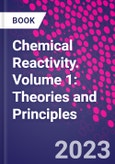The growth of technology for chemical assessment has led to great developments in the investigation of chemical reactivity in recent years, but key information is often dispersed across many different research fields. Combining both original principles and the cutting-edge theories used in chemical reactivity analysis, Chemical Reactivity, Volume 1 present the latest developments in theoretical chemistry and its application for the assessment of chemical processes.
Beginning with an exploration of different theories and principles relating to electronic structure and reactivity of confined electronic systems, the book goes on to highlight key information on such topics as Dyson orbitals, target-ion overlaps, reaction fragility, magnetizability principles and the Fuki function. Density Functional Theory is discussed in relation to numerous different principles and approaches, with further information on constrained methods and diabatic models, bonding evolution theory, orbital-based population analysis models and charge transfer models, and Quantum chemistry and QTAIM.
Consolidating the knowledge of a global team of experts in the field, Chemical Reactivity, Volume 1: Theories and Principles is a useful resource for both students and researchers interested in gaining greater understanding of the principles and theories underpinning chemical reactivity analysis.
Please Note: This is an On Demand product, delivery may take up to 11 working days after payment has been received.
Table of Contents
1. The importance of correlation in the molecular orbital picture
2. Dyson orbitals and chemical bonding
3. Coupled-cluster theory and chemical reactivity
4. New developments in the Interacting Quantum Atoms (IQA) approach
5. Conceptual Ruedenberg theory of chemical bonds: the necessary step beyond conceptual DFT
6. Electron-density-based analysis and electron density functional theory (DFT) methods
7. Information-theoretic concepts in theory of electronic structure and chemical reactivity
8. Excited-state density functional theory
9. Reaction fragility method: monitoring evolution of atoms and bonds on a reaction path
10. Looking behind the scenes of Grubbs catalysis with the Unified Reaction Valley Approach
11. The diabatic model of intermediate stabilization for reaction mechanism analysis: a link to valence bond and Marcus theories
12. Main concepts and applications of DFTB approach
13. Chemical reactivity insights from the use of constrained methods
14. On the analysis of the Fukui function
15. Analytic calculation of Fukui functions and related reactivity descriptors
16. New insights from a bonding evolution theory based on the topological analysis of the electron localization function
17. Experimental quantum chemistry and chemical reactivity
18. Quantum similarity description of a unique classical and quantum QSPR algorithm in molecular spaces: the connection with Boolean hypercubes, algorithmic intelligence, and G�del's incompleteness theorems







